1. Guest Spot: Creating AR Customer Lists
(by Eric Tu, Software Engineer, The College Board)
To maintain your organization’s strong financial standing, you need to closely manage your company’s Accounts Receivable. With the looming slow down of the US economy, this becomes even more critical. You can enlist the help of your customer representatives to assist with timely AR collection. The information you need to provide them, of course, is their account’s AR information.
If your company has been diligent and set up each of your customers with a Sales Rep code, you are in good shape to get started. A number of Lawson AR reports can be run by Sales Rep as part of the selection criteria. If you have the 8.1/9.0 Lawson Applications, you can use MX10 to create a customer list based on Sales Rep, and then run AR reports based on that list.
But what if you haven’t assigned Sales Rep to each of your customer? You can try using the 50 or so parameters available on MX10 to create a similar type of list. However, an easier method is to use Lawson’s Excel Add-In. If you extract a list of customers with the Add-In, or manually create one, you can then upload it to create a manual customer list.
First, you need to create a list header record in MX10. Enter the Object Type as CUST, and LIST as REP1:
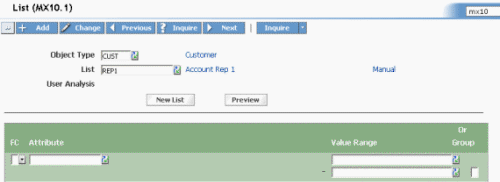
When you click ADD, MX10.2 will open; enter a description for the header, such as Account Rep 1:

Open up Excel, and fill in the four required columns:
- Column A = Object Type = CUST = _f6,MLH-OBJ-TYPE
- Column B = List = REP1 = _f7,MLH-MATRIX-LIST
- Column C = Company = 1 = f15,ACM-COMPANY1
- Column D = Customer ID = 9077435## = _f16,ACM-CUSTOMER1
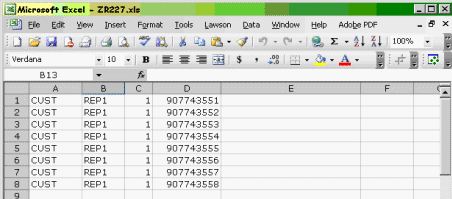
Next, start up the Lawson Excel Upload Wizard. Select your Product line, System Code AR, and Form AR23.4.
NOTE: While the List header records are entered in MX10.x, the manual list you are creating is entered (and edited) on AR23.4.
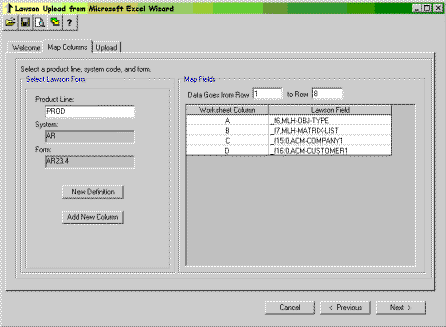
Once you have mapped the columns to the fields, save the Add-In (.uwf) file. Then, click “Next”. Select “Try to Add, and then try to Change”, then finally, Upload:
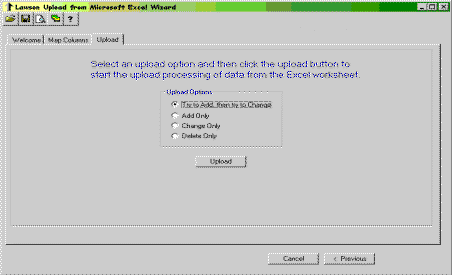
Once you see the upload completed confirmation, you can close Excel.
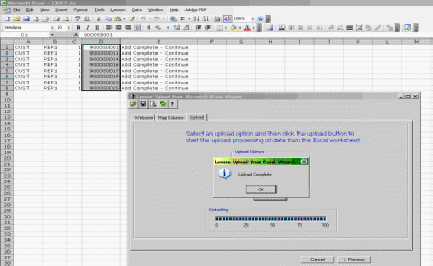
Back in Lawson on the MX10.2 screen, click “Preview”; AR23.3 will display the list of customers you have just added:
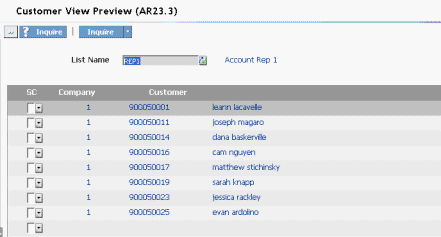
Once you have the list, you can use it with any AR program that has Customer List as a selection parameter. Some examples are:
- AR130 Balance Forward Application
- AR135 Automatic Transaction Removal
- AR250 Customer Aging Report
2. ProcessFlow Integrator, Part 3: What's in the Box?
So far in this article series, we’ve looked at high-level integration concepts that can be achieved using ProcessFlow Integrator. Now it’s time to dig in a little deeper. In this article, we’ll look at what differentiates the different editions of Lawson ProcessFlow. To do that, we first need to look at what’s included when you purchase ProcessFlow.
The primary components of Lawson ProcessFlow are:
-
ProcessFlow Server: The “engine” that executes flows which you have developed and deployed to the server. This component is installed as part of LSF9, and runs on the Lawson Application Server: There is a small command-line utility, called pfserv, which you run on the server to configure ProcessFlow.
-
Event Management Console: Desktop component used to manage ProcessFlow server and log files.
-
Scheduler: This component is a desktop component which works in conjunction with the ProcessFlow Server, for time-based initiation of flows.
-
Administrator: Desktop component for managing Work Units associated with flows, and capture details; also used for troubleshooting “stuck” flows.
-
Web Administration: There is a set of web-based (e.g., http://server/bpm/menu.do) forms which replace the LOGAN WFxx forms
-
ProcessFlow Designer: This is the desktop tool you use to actually build your flows. It’s what is available to you in the Designer that makes up the different editions of ProcessFlow.
What Do I Need to Use ProcessFlow?
The good news is that the requirements for implementing ProcessFlow are the same as for implementing LSF9:
- Lawson System Foundation (LSF9)
- IBM WebSphere Application Server
- LDAP Server
- MS ADAM, or
- Tivoli Directory Server
- Database
- IBM DB2, or
- Oracle, or
- Microsoft SQL Server
In other words, if you have LSF9, you have everything you need!
Building a Flow
Assuming your LSF9 installation is already complete and properly configured, you’re ready to start using ProcessFlow. That means you need to become familiar with the ProcessFlow Designer. You use the Designer to fasten together a collection of “Activity Nodes” to orchestrate a business process, such as this simple one:
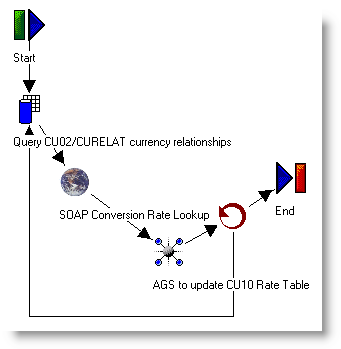
Activity Nodes are connected together to represent logic; each Activity Node can use the output of previous Node(s) as its input (i.e. that’s what makes up the “flow”). While some Activity Nodes are self-contained (i.e. they perform a defined function), some nodes can be extended via JavaScript; Lawson supplies some functions, but you can customize to meet your own needs.
Meet the Nodes
Within the ProcessFlow Designer, there are over 25 built-in activities available for you to use to perform workflow and integration functions:
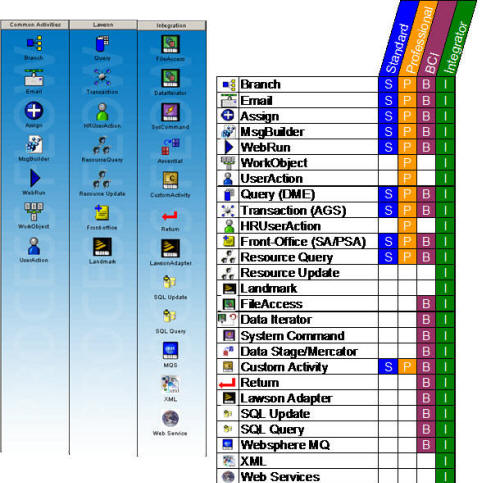
ProcessFlow Editions
- ProcessFlow Standard, which is included with your Environment / LSF9 purchase. ProcessFlow Standard provides basic workflow capability, with the ability to query against Lawson tables, update Lawson forms, send emails, etc. But ProcessFlow Standard does not include the orchestration and integration features provided by ProcessFlow Professional and Integrator.
- ProcessFlow Professional, an upgraded version of Standard, which adds user actions and work objects (we’ll cover those topics in future articles, but suffice it to say that they are way in which you assign and manage process-driven work within an organization)
- ProcessFlow Integrator, includes all of the capabilities of Standard and Professional, but adds—most significantly—the ability to integrate with other systems, via SQL database connections, web services, files, etc.
- Business Component Integrator, which has been upgraded in LSF9 to use the ProcessFlow Designer, and includes most of the capabilities of ProcessFlow Integrator but not the user actions and work objects included in ProcessFlow Professional and ProcessFlow Integrator.
Note: Lawson recently issued a decommission notice for ProcessFlow Professional (effective June 1, 2010) and Business Component Integrator (effective June 1, 2009); customers of those products will need to migrate (for a fee) to ProcessFlow Integrator in order to retain the current functionality of their respective product.
3. Worthwhile Reading
SOA's Perfect Mate?
Virtualization 2.0 will go beyond server consolidation, making applications more agile and scalable to fit a service-oriented architecture.
Information Week, February 4, 2008
http://www.informationweek.com/story/showArticle.jhtml?articleID=206100656
The Balanced Approach to Managing Risk
While Sarbanes-Oxley shook up the world of publicly traded companies and forced them to scramble to achieve compliance, it also played a pivotal role in bringing enterprise risk management (ERM) to the attention of corporate executives.
BIReview.com, February 14, 2008
- QUOTE OF THE ISSUE –
“Courage is what it takes to stand up and speak;
courage is also what it takes to sit down and listen.”
-- Winston Churchill
http://www.bireview.com/bnews/10000828-1.html
What's Wrong with the Kids?
Coping with the newest generation in finance requires tact, patience — and restraint.
CFO Magazine, February 2008
http://www.cfo.com/article.cfm/10597009
4. Lawson Tips & Tricks
Troubleshooting LSF9 Application Security
There's no doubt--Lawson Application Security in LSF9 is more robust, and therefore more complicated, which makes it harder to troubleshoot. Fortunately, you have some visibility--unlike with LAUA security--into the rules engine. You can turn on debug/trace (in this instance I'm only doing it for one user):
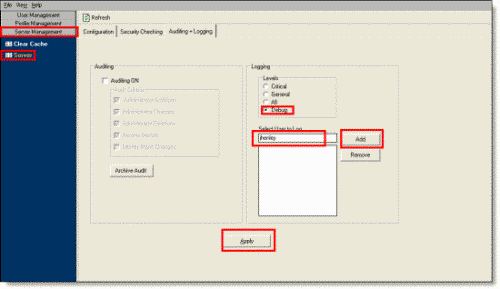
This setting will log the rules--as they are applied--to the lase_*.log files in the Lawson system directory (i.e. %LAWDIR%\system). In this instance I'm trying to figure out what rule is allowing access to AP150. Remember that with Lawson Security, the first rule encountered that grants access ends the rules processing. I can see that the ESS security class is the culprit:
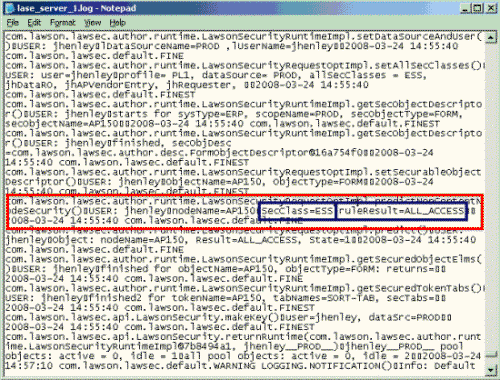
Back in Lawson Security, I can determine that the ESS class grants access to the securable type of FORM:

However, I'm also assigned a class/role which grants access to the AP system code/category:

What's happening is that the rules are being combined, and because I'm granted access to the securable type of FORM as well as access to the AP system code/category, I'm therefore granted access to ALL forms in the AP system codes.
Using the debug logging in LASE, you can quickly figure out what the rules are applied, and their impact; just remember to turn off the debug logging when you're done!